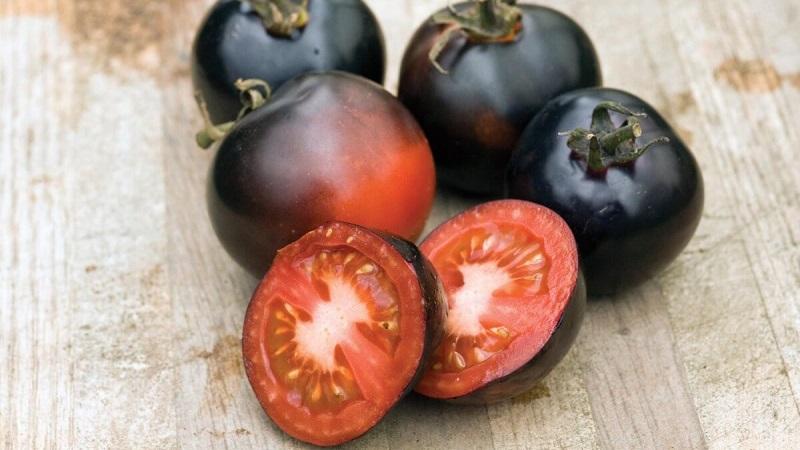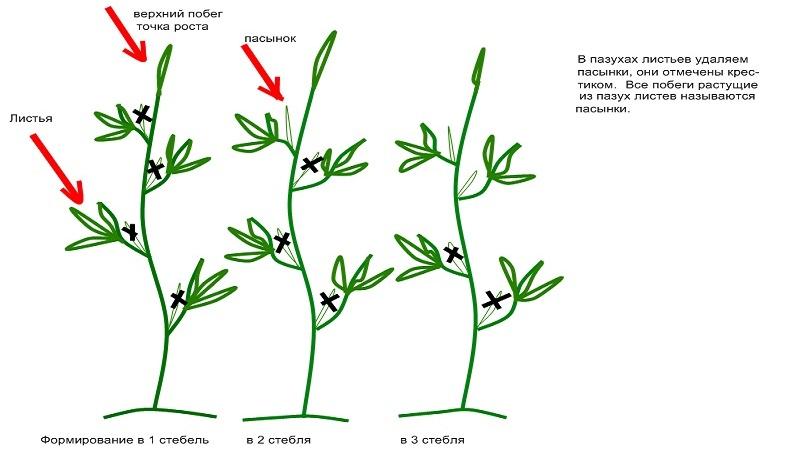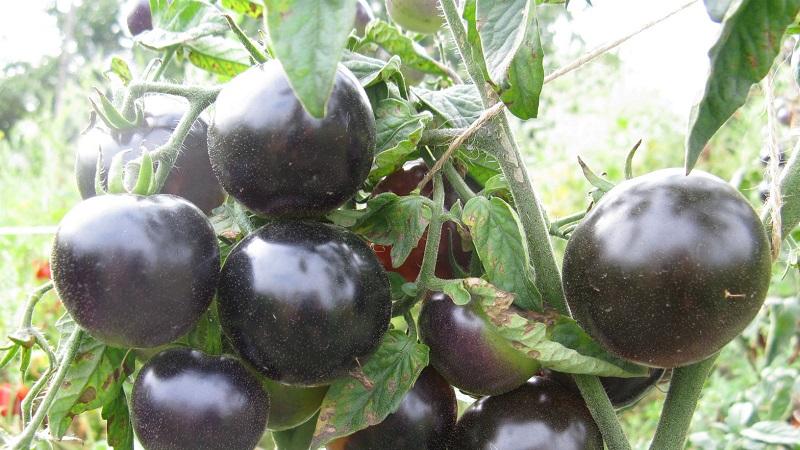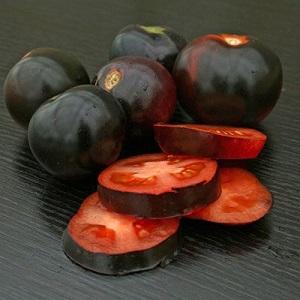Tomato growing technology "Indigo Rose" for beginners and experienced farmers
Thanks to its bright appearance and interesting taste, the Indigo rose tomato has won the love of many fans. However, some are scared that the fruits of this variety are almost black, mistakenly considering them unnatural and harmful.
Experts are in a hurry to calm down: this type of tomato is bred exclusively in a natural way. Moreover, the Indigo rose tomato, the characteristics and description of the variety of which will be presented below, has unique beneficial properties.
The content of the article
Description of the variety
The main distinguishing feature of Indigo Rose is the dark color of the fruit, which can range from deep purple to blue. There are also several similar varieties of tomatoes, which are dominated by blue, purple and dark crimson colors.

Indigo apple
Tomato Apple indigo is one of the varieties with a predominance of dark color. The plant has rather large fruits, weighing up to 150 grams. In terms of cultivation and care, it practically does not differ from Indigo rose.
The only difference is that the fruit is not completely black, but only at the base. Depending on the exposure to sunlight during the ripening period, black color may prevail or be less pronounced.
Distinctive features
Among the features of the Indigo rose tomato should be highlighted:
- early ripening;
- bush resistance to disease;
- the ability to grow both in the greenhouse and in the open field.
Fruit characteristics, yield
An indigo rose tomato bush forms a cluster of 6–8 tomatoes.
The dense skin of the Indigo Rose tomato fruit allows you to harvest them for winter... The inside of the tomatoes is red in color and has a pronounced spicy aroma.
It is noted that tomato has an unusual rich taste.
The black color of the fruit is due to the high content of anthocyanins. This substance is found in plants, vegetables and fruits and gives them blue, purple and red color. On humans, anthocyanins have a bactericidal, immunostimulating and anti-edema effect.
Note. Fruits and vegetables containing anthocyanins are powerful antioxidants. This means that they promote free radical scavenging, preventing the development of many diseases.
How to grow seedlings
Let's take a closer look at how to properly grow seedlings of this tomato varieties.
Seed preparation
First of all, the seeds need to be treated with a 1% solution of potassium permanganate or "Fitosporin". To do this, you can use moistened cotton pads or gauze, in which they are placed seed.
In conditions of high humidity and constant high temperature, the seeds will sprout quickly.
Important.We recommend using a growth promoter to increase the chances of successful germination. It can be purchased at any gardening store.
Capacity and soil
For convenience, you can plant seeds directly in separate pots. So you can save the future plant from unnecessary stress and an additional period of adaptation of seedlings when picking. Used by priming for tomatoes or ordinary seedling soil.
Sowing
The hatched seeds are planted in the ground. Someone sprinkles it with ordinary earth, someone uses earth calcined in a pan.There is not much difference, especially if you use purchased soil for tomatoes. It does not require additional processing.
Growing and care
After the first shoots, it is important to prevent the seedlings from pulling out. To do this, it is better to move it to the brightest place or provide artificial daylight.
The most optimal temperature for the full growth of an Indigo rose tomato is 22 degrees during the day and 18 degrees at night.
You can water the first time with a spray bottle, then from a watering can. Often you do not need to water - the main thing is that the soil does not dry out completely.
When the first 2-3 leaves appear, you can feed it with a weak solution of mineral fertilizer - for example, by dissolving 50 g of nitrophoska in 10 liters of water. After two weeks, you should repeat the feeding.
How to grow tomatoes
At the age of 50 days, the seedlings of the Indigo rose tomato are ready for planting in a greenhouse or in open ground.
Landing
Seedlings are planted in separate holes, according to the scheme 40-50x60 cm.
Attention. You should start planting tomatoes if there is no threat of night frosts on the soil.
To retain moisture and maintain oxygen exchange, the soil around the bush is mulched with natural materials. You can use pine needles, bark or wood chips.
Care
The soil around the tomatoes is weeded as needed. If the soil has not been mulched, it must be loosened, preventing a hard crust from forming around the bush. Indigo rose does not require frequent watering, 1-2 times a week is enough.
The bush is formed in 2 stems, in extreme cases - in three. The tomato needs regular pinching. It is extremely important to remove stepchildren in time, otherwise the stem will grow, and it will no longer have the strength to form fruit.
How to correctly identify the stepson and remove him, you can look at the photo.

When the bush reaches a large size, it needs to be tied up. You can use greenhouse pegs or beams to do this. Be careful not to damage the stem when tying.
You can feed tomato bushes several times, alternating mineral and organic fertilizers, for example, an infusion of cow dung dissolved in water in a ratio of 1: 5.
Features of cultivation and possible difficulties
Tomato Indigo rose does not like sudden changes in temperature. Temperature conditions should be monitored carefully. It is important not to allow hypothermia or exposure to too high temperatures.
The rich dark color of a tomato is due to a sufficient amount of sunlight. Plant in a sunny location to achieve a bright color.
Diseases and pests
A feature of this variety is a high degree of resistance to late blight and other "tomato" diseases. But we advise you to perform elementary preventive actions.
To do this, a couple of times a season, you should spray the tomatoes with a special solution against insect pests (you can buy it at a gardening store).
The nuances of growing in open ground and in a greenhouse
Indigo rose grows equally well in the open field and in the greenhouse. In the northern regions, it is preferable to grow this tomato in a greenhouse so that the plant does not overcool.
In general, reviews of gardeners and farmers indicate that with proper care, Indigo rose gives good yields both in the greenhouse and in the garden.

Harvesting and application of the crop
A tomato is considered ripe if it has acquired its characteristic rich color and has become a little soft. You can pick the fruit a little earlier, and it will ripen already indoors. However, in this case, uneven pigmentation may appear.
The variety is ideal for harvesting whole, drying, fresh use and preparing various dishes.
Advantages and disadvantages of the variety
Of the advantages, gardeners note that the Indigo rose is a powerful and compact bush. Fruits are medium-sized, juicy, can be stored for a long time due to their dense skin.
The variety does not require additional knowledge of agricultural technology; it is grown like most other tomatoes.
Of the shortcomings, one can single out only that the fruits of this variety do not reach large sizes. Indigo rose, although considered early ripening, ripens for a long time in the northern regions.
Farmers reviews
 Farmers from the middle belt and northern regions of Russia face difficulties in growing Indigo roses. Problems arise with long maturation and the appearance of diseases caused by a humid and cool climate.
Farmers from the middle belt and northern regions of Russia face difficulties in growing Indigo roses. Problems arise with long maturation and the appearance of diseases caused by a humid and cool climate.
Natalia, 43 years old, Saratov:“My hobby is growing tomatoes, and every new season I want to plant something interesting. Once I stumbled upon Indigo Rose tomato seeds. In appearance, Indigo seedlings differ from other varieties in their characteristic dark purple hue. The plant itself grows up to 1.5 m. The fruits are small and sweet. I really like the color of these fruits: unripe they are purple-green, and ripe ones are black-red, although the flesh in the middle is bright red. "
Lyudmila, 37 years old, Bogorodsk:“The germination is excellent! All the seeds that I sowed have sprung up! They grew as in the picture, one bush to one. Sowed on March 10, dived once, and planted in the ground in May. Shaped into 2 stems. It is a little unclear when to collect them. I waited for the already black tomatoes to become soft. They did not, because they have a dense skin. I brought it home - the smell was all over the kitchen. I annoyed the guests for the winter, surprised the guests for the holidays ”.
Sergey, 54 years old, Vologda:“They were the first to get sick with late blight. But! Some bushes still gave a crop. The taste is not for everybody, my wife did not like the cloying smell. Nevertheless, I believe that it is worth planting them at least once. "
Conclusion
Indigo rose is a beautiful black tomato. It is beneficial for the human body, as it contains anthocyanins, which reduce the risk of many pathologies and lower blood sugar levels. Differs from other varieties in taste and smell.
The cultivation is simple. Depending on the area of cultivation, the yield and size of the bush differ slightly. In the northern regions, this variety ripens longer than in the southern ones.
Trying to grow such a tomato is definitely worth it - it has already earned the reputation of experienced farmers and newcomers to gardening.